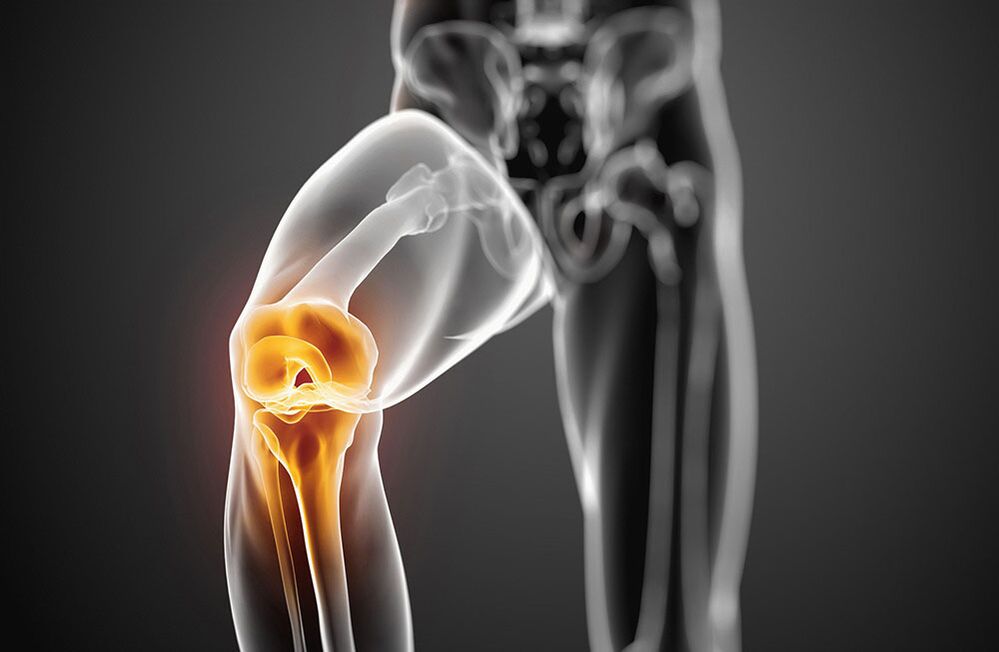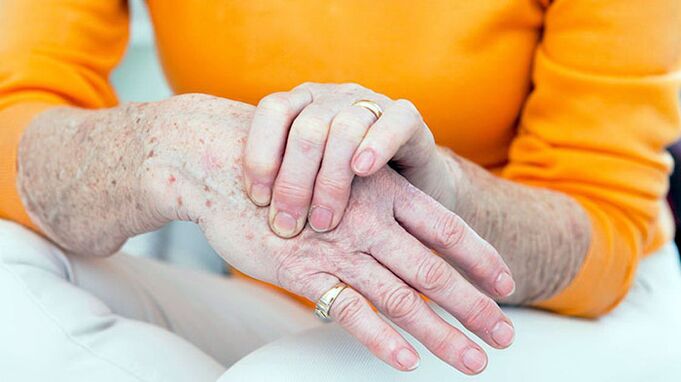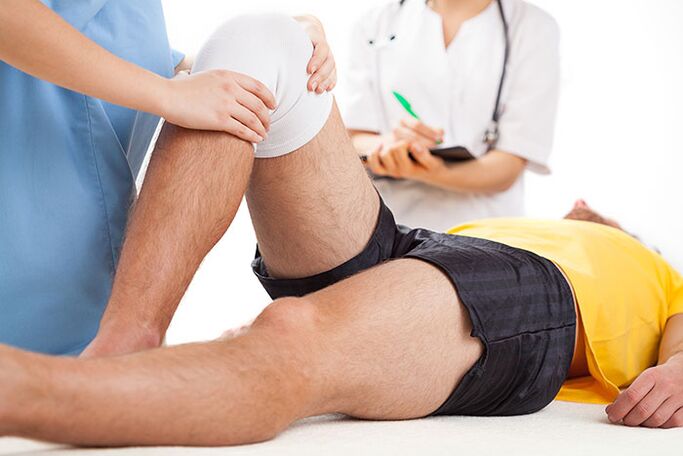
From childhood, we get used to running, jumping, boys love to climb and play football, girls in strings and much more.And the active lifestyle is entering both the human mind that over the years, when somewhere the muscle took out, somewhere the articulation fell ill, the person does not even pay attention."Well, think how many times the Kolenko hurts."Here in today's article we will talk, and why the knee can hurt, and if this is always the usual result of the acute movement.
What is osteoarthritis?
Osteoarthritis -A group of diseases of the musculoskeletal system of different origin, but with similar biological, morphological and clinical manifestations.The basis of its development is the degenerative lesion of all components of the joint, mainly cartilage, thin bone, synovial membrane, ligaments, capsules and periarticular muscles, with the formation of marginal osteophytes and a clearly pronounced moderate or hidden withoutvitis.Since with this disease, pathological changes capture both cartilage and bone tissue.
Arthrosis is often called osteoarthrosisAnd sometimes osteoarthritis.
Statistics (epidemiology)
Among all articulations diseases, osteoarthritis is up to 80% of cases.
The disease develops mainly in Middle Ages and old age.At an early age, osteoarthritis can occur after joint injuries, inflammatory processes, as well as congenital pathology of the musculoskeletal system.
Signs of X -ray osteoarthritis are detected in most people over 65 and almost 95%of more than 70 years.
Women suffer from osteoarthritis almost twice more often than men.The incidence rate increases during postmenopause.
An important role in the development of osteoarthritis is performed by hereditary factors.It was established that the frequency of disease development in families of patients with osteoarthritis is twice greater than in the population as a whole, and the development of osteoarthritis in people with congenital defects of the musculoskeletal system increases 7-8 times.
Osteoarthritis - ICD
- MKB-10: M15-M19, M47
- MKB-9: 715
- MKB-9-KM: 715.3

Symptoms of osteoarthritis (clinical image)
The clinical manifestations of the disease and its severity depend on the location of the pathological process, the patient's health status and the image of his life.
The first signs of osteoarthritis
Arthrosis often begins gradually, imperceptibly for the patient.
The first symptom of the disease is usually a short -term joint pain (arthralgia), which carries the largest load.These are, first of all, the joints of the lower extremities: the knee, hip, plus-falanx joints of the first thumb of the foot.From the upper limb joints, the interfalngas joints, the articulation of the carpal pattern of the thumb of the brush are more often affected.
Arthrosis generally begins with the injury of an articulation, but after a while, other joints are involved in the process.
The main symptoms of osteoarthritis
With osteoarthritis, patients complain of pain, crunch, restriction of movements in the joint, swelling and joint deformation.
Separately, it is worth thinking about the nature of pain.With osteoarthritis, mechanical and initial pain is possible.Mechanical pain occurs with the load in the affected joint.Such analgesics mainly at night at rest, disappear after several hours of rest.The appearance of this type of pain is associated with a gradual increase in bone pressure during physical effort.The pressure causes bone beams and irritation of the painful bone tissue.
The initial pain appears at the beginning of the walk, then stops quickly and occurs again during physical effort.The initial pain may appear with the friction of the articular surfaces of the affected joint.Small necrotic cartilage particles fall on cartilage surfaces.In the first steps, these particles push themselves to the cavity of the joint bag and pain ceases.
With osteoarthritis, pain can be associated with periartritis and tend (inflammation of soft periarticular tissues, ligamentary devices and joint bag).This pain occurs only during the movements in which the affected tendons participate, as well as in certain positions of the articulation during the movements.
The pathological changes, as a rule, begin with large joints, which are subject to great physical effort during the day.At the beginning of the disease, pain occurs as a result of the inconsistency of the possibilities of the microcirculatory channel with the needs of joint tissues.Therefore, to reduce pain, patients slowly take the first steps and only then accelerate the rhythm of walking.The pain can appear after half to two hours walking or working in a standing position.This is a signal to change the load, short -term rest or the type of work.
In the posterior stages of the disease, arthralgia can occur with minimal loads in the joint and remain at rest for a long time.This is due to the fact that in the posterior stages, rude changes in joint tissues, the destruction of the joint cartilage and the secondary synovitis are formed.With the development of mass and gross changes in bone tissue, their individual fragments can be separated and, falling into the articular gap, cause acute pain.This phenomenon is called articular mouse symptom.
During the joint exam, the deformation is remarkable.In addition, with osteoarthritis, there is a thickening of the tissued tissues, hypotrophy of the regional muscles, displacement of the axis of the limb.The thickening of the interphalangeal joints with bone growth and the seal of periarticular fabrics is called Gerberden nodes.
Pain when feeling the joint is located in the articular gap, the places of union of the articular capsule, but this symptom of the disease is not always.Swelling and joint pain are determined by secondary synovitis.
The violation of the joint function in the early stages of osteoarthritis is manifested by a limitation of the amplitude of the movements.This is due to the lesion of periosematic tissues and synovitis.
In the posterior stages of the disease, the clinical manifestations of contractures develop different in terms of gravity.Very often, the functions of knee and hip joints are affected.
Symptoms of osteoarthritis depending on the location of pathology
Osteoarthritis with damage to knee joints - symptoms
The knee joint injury with osteoarthritis is called gonarrosis.Primary gonarrosis develops in women in menopause.The reasons of high school are often the injuries of the knee joint and a rape of the statistics with curvature of the spine, flat feet.Patients complain of pain in the knee joint that occurs during movements, especially when climbing the stairs.The pain is located in the front or inside the knee joint.The movements in the joint are limited: first flexion and posterior extension.When moving, a crunch often appears.With the development of reactive synovitis, pain during movements intensifies and worries at rest.The swelling of the joint is determined, pain during palpation, redness (hyperemia) and an increase in skin temperature.Over time, due to bone growth, the deformation of the knee joints occurs.
Osteoarthritis with damage joints - symptoms
Hip joint injury is called cooksis.This is the most serious form of osteoarthritis.The causes of the disease can be the congenital dysplasia of the hip joints, the lesions, the menopause.Patients have joint pain during movements, standing position.The restriction of movements in the Board increases gradually (first internal and external rotation, posterior flexion).There is a limp associated with the shortening of the limb.With bilateral damage, the duck march is typical.Atrophy of the muscles of the thighs and the buttocks develops.There is no swelling of the joints with carmosis.Palpationally determines the limited pain in the femoral head.
In the initial stage of osteoarthritis, joint functions are preserved.With the additional development of the disease, it is first temporarily limited, and then the ability to work is completely lost, the patient loses self -care, needs external help.
The causes of osteoarthritis
Arthrosis is based on the primary degeneration of articular cartilage with the destructive changes that accompany the bones that form the joint.Such degeneration occurs as a result of an imbalance between mechanical loads on the surface of the cartilage joint and the possibility of compensation for this load.
In the development of degenerative changes in joint cartilage, several factors can participate simultaneously:
- Functional overloads, including professionals, domestic and sports, which cause mycotrauma of cartilage;
- joint injuries;
- Infectious and not specific inflammation of the joint;
- joint dysplasia, which leads to a violation of the comparison of articular surfaces;
- Violation of body statistics as a result of the curvature of the column (kyphosis, scoliosis, pathological lordosis, etc.), flat feet;
- Chronic hemartrosis:
- diseases with metabolic disorders (gout, obesity, chondrocalcinosis);
- Osteodistophy or pedget disease;
- osteomyelitis;
- Peripheral nervous system pathology with loss of sensitivity;
- Endocrine pathology (acromegaly, diabetes, amenorrhea, hyperthyroidism);
- Hereditary trend.
Arthrosis risk factors include elderly, female sex, obesity.
Development mechanism
Metabolic disorders in the cartilage are based on quantitative and qualitative changes in the main substance of the cartilage.The main substance consists of proteoglycans that provide collagen stability.The development of osteoarthritis is accompanied by insufficient formation or greater destruction of cartilage components.
With osteoarthritis in cartilage tissue, the content of hyaluronic acid, chondroitin and keratin decreases.In addition, altered proteoglycans lose the ability to retain water.It is absorbed by a collagen that swells, causing a decrease in cartilage resistance.
If the chondrocytes are damaged, they begin to produce collagen and proteoglycans, not characteristic of normal cartilage tissue.These altered substances cause the loss of biochemical qualities of the cartilage.
Of great importance in the development of osteoarthritis are immune disorders.The destruction of cartilage proteoglycans is accompanied by the appearance of immune reactions of the cell and humoral type.In turn, this causes progressive fibrosis and synovial membrane sclerosis, pathological changes in intra -articular synovial fluid and cartilage violation.The lower synovial cover supports the progression of degenerative changes in the articulation cartilage.
A hereditary factor has a certain value in the development of osteoarthritis.
Classification of osteoarthritis
Arthrosis is divided into two groups: primary and secondary.
In distribution (primary osteoarthritis):
- local (with damage to three joints)
- Common or generalized, polyartrosis (defeat of three joints or more).
Depending on the destination (secondary):
- A. Tasobada articulation (cokesartrosis);
- A. The knee joint (gonarrosis);
- A. The elbow joint;
- A. The shoulder joint;
- A. spine;
- A. Cervical Department (unkoarthrosis);
- A. Hands;
- A. Ankle joint (crucosis)
- A. Stop.
By etiology:
- post -traumatic
- metabolic
- Due to endocrine pathology.
Diagnosis of osteoarthritis
The variety of clinical manifestations and variants of osteoarthritis hinders the early diagnosis of the disease.The falsehood of the diagnosis is also associated with the lack of specific symptoms, the hidden beginning of the disease.Of great importance is the definition of factors that contribute to the development of osteoarthritis:
- chronic articular trauma;
- long -term execution of stereotypical movements;
- Physical activity in the articulation for a certain time;
- Violation of salt or fat metabolism;
- Hereditary vices of the musculoskeletal system.
An X -Ray exam is the most important meaning in the diagnosis of osteoarthritis.An radiography of visualization of both knee joints is performed in a direct position, a folded position, also in a lateral position.The classic signs of osteoarthritis in the radiography are: narrowing of the articular gap, the presence of osteophytes, subcondral bone sclerosis and subcondral cysts.There are the following stages of radiological changes in osteoarthritis:
- 0 - There are no changes.
- Yo - Radiologically doubtful signs.
- II - Minimum changes (slight narrowing of the articular gap, osidiaria osteosclerosis, individual osteophytes).
- III - Moderate manifestations (moderate narrowing of the letter, multiple osteophytes).
- IV- Expressed changes (the articular gap is not visible, multiple rude osteophytes are determined), synovitis is often present.
In the presence of these symptoms, no more tools are needed.
In its absence or low gravity, joints, magnetic resonance, spindle, are carried out.
Clinical blood tests, urine and intra -articular synovial fluid are not included in the list of mandatory studies for the diagnosis of osteoarthritis.But these tests are necessary to exclude such joint pathologies.
The main clinical and diagnostic signs of osteoarthritis:
- Mechanical articulation pain;
- fatigue;
- a feeling of instability in the joints of the lower extremities;
- damage to the joints of the first finger of the foot and hands;
- the gradual beginning of the disease;
- slow progressive current;
- joint deformation;
- regional muscles hypotrophy;
- recurring synovitis;
- restriction of movements in the joint;
- X -Ray changes.
Arthosis should be differentiated with the damage to the joints with rheumatoid arthritis, infectious, metabolic and reactive arthritis.
Rheumatoid arthritis, unlike osteoarthritis, begins with the inflammation of the small joints of the hands and feet.It is characterized by intense pain of the inflammatory type, the morning stiffness of the joints, the presence of rheumatoid nodules.
Getric arthritis is mainly found in men.The high local activity with acute paroxysmal pain in the first more phalanx joint of the thumb of the foot is characteristic.With the drop, the presence of Tofus is typical, in the radiography there is "blow".
Psoriatic arthritis is characterized by skin lesions, especially scalp, fingers -shaped deformation and a bright skin color of the skin on the affected joints.
Infectious arthritis is characterized by acute beginning, rapid development and course, acute pain, high temperature and the effectiveness of antibacterial therapy.

Treatment of osteoarthritis
The treatment for osteoarthritis must be long, complex.The basic principles of osteoarthritis treatment:
- Joint discharge (correct mobility mode and mechanical loads, dosing walk, reduce body weight, exclusion of prolonged position, the use of weights, strengthen the muscle ligament apparatus using physiotherapy exercises, massage, electrical stimulation).
- Conservative correction of static disorders (use of orthopedic shoes, corsets, supervisors).
- The impact on general metabolism and blood circulation (the use of bio -stimulants, vasodilatory drugs, balneotherapy and physiotherapy courses twice a year).
- Elimination of reactive synovitis, anti -inflammatory therapy.
Arthrosis patients show a diet with a limitation of salt, sugar, strong tea, coffee, smoked meats, sharp dishes.This improves the sensitivity of vascular and joint receptors, restores the tone of blood vessels, normalizes the exchange in chondrocytes.With osteoarthritis, it is necessary to drink enough liquid (at least 8 glasses of water per day).
The pharmacological treatment of osteoarthritis includes the use of anti -inflammatory and rapid action analgesics (non -steroidal anti -inflammatory drugs -Aine), basic medications -condroprotectors.No-?Non-selective and selective TSO-2 inhibitors are used from NSAIDs.
As local therapy for affected joints, NSAIDs are used in the form of ointment or gel.
In the presence of reactive synovitis, tendonitis or teaching, when NSAID treatment is ineffective, appropriate, the intra -articular or intramuscular administration of corticosteroids.
Basic condoprotective therapy (chondroitin, glucosamine, hyaluronic acid) is used to prevent articular cartilage degeneration.
The treatment of condoprotectors is indicated in the I-III clinical and radiological stages of osteoarthritis.
In addition to direct condoprotectors, drugs are used that stimulate cartilage tissue (biogenic stimulants).These medications are used during remission, in the absence of reactive synovitis.
With osteoarthritis, medications that improve microcirculation are also indicated.In the presence of varicose veins of the lower extremities, the correction of venous blood flow is necessary.
In patients with osteoarthritis, it is necessary to diagnose and treat osteoporosis in a timely manner.
Arthrosis physiotherapy
Physical treatment methods are also related to basic osteoarthritis therapy.Under its influence, metabolic processes are stimulated, the microcirculation of blood and tissue fluid is stimulated, neurogoal regulation is restored.
The osteoarthritis treatment complex includes inductoral, microwave therapy, pulsed currents, medication electrophoresis and magnetotherapy.To eliminate synovitis, ultraviolet irradiation of the area of the affected joints in erythema doses, an ultra -high frequency electric field, electrophoresis with analgin, tellxide or hydrocortisone is used.
For the prevention of the progression of osteoarthritis, it is recommended to reduce body weight, avoid greater loads in the joints, walk in a suppressed area, greater moisture and hypothermia.An individual selection of shoes and supervisors is important.
With gonarrosis, regular physical exercises, swimming, cycling is shown to strengthen the muscles.Heavy and light and light athletics classes are not recommended.
Therapeutic exercises are carried out differently, in the sitting position, lying down, in the pool.The movements should not be intense, traumatic, its volume and their number of repetitions gradually increase, avoiding overloads.
Popular and effective methods to treat osteoarthritis also include massages and thorapy kines.
With significant changes in joints with deformation, mobility restriction, surgical treatment is recommended.Artroplasty, endoprothetic, osteotomy are performed.
The prognosis of the disease
Primary osteoarthritis rarely leads to a complete disability.In the presence of reactive synovitis, patients are temporarily disabled and, sometimes, they are forced to change the profession.With secondary caps, the prognosis is less favorable due to the rapid progressive course of the disease with the development of articular functions with significant disabilities.In such cases, disability can occur for several years of illness.
Osteoarthritic prevention
The primary prevention of osteoarthritis should begin in childhood.It's as follows:
- prevention and treatment of scoliosis;
- Flat feet correction using special supervisors;
- Physical education classes to strengthen muscles and ligaments;
- rational nutrition and prevention of metabolic disorders;
- Heavy sports restriction in childhood and adolescence;
- Alternate work sitting on a table with walking;
- The correct organization of the work and the rest of the employees of the companies where there is a great physical activity.
Secondary prevention establishes measures that avoid the development of recurring reactive synovitis.These include walking, restriction of physical effort, walking with support and other measures that download the joints.With severe symptoms of osteoarthritis, it is necessary to constantly take basic medicines.General strengthening therapy, the improvement of blood circulation and metabolism, annual spa treatment, is recommended.
Which doctor will go?
- Rheumatologist
- Orthopedist



















